Late in 2021, I received word that the Redwood City Marina Pier was undergoing a total rebuild. Given that the original pier had been constructed way back in 1959, it made sense. I began to follow news about the pier and decided I would attend the grand opening celebration scheduled for March 3, 2022. But, it was not to be. Rain, much needed rain, and something missing during early months of 2022, would show up the week of the grand opening. A multi-day trip planned around the opening, one that would allow for visit to all of the peninsula’s piers, now coincided with the projected days of rain. Preferring better weather, the trip was pushed back. Instead, the day I would first visit the new pier would take place on March 13. It was 1`0 days after the opening but the pier was still like new.
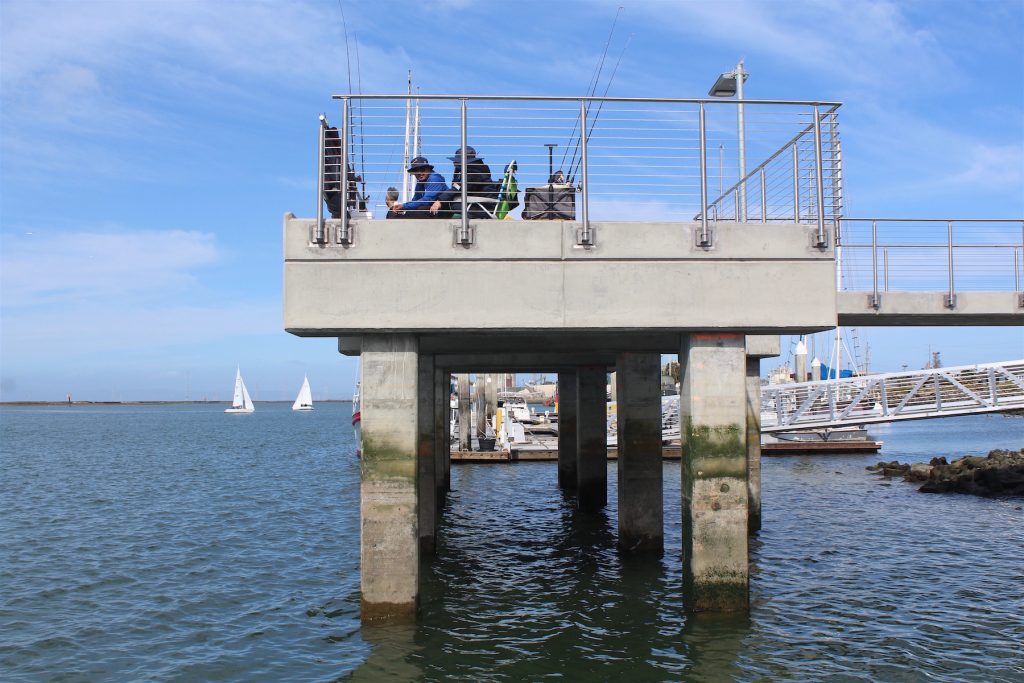
Environment. The pier was built in the same location as the old pier but otherwise is almost totally different being an all metal pier versus wood, having concrete pilings instead of the old wood pilings, and being somewhat larger. Unfortunately, most of the amenities that accompany a good fishing pier are missing. No benches upon which to sit, no rod holders on the slippery railing, no bait cutting boards, no fish cleaning sink, and basically no lights for night fishing (although one solitary light is on the pier). A little input from anglers (or someone like myself) might have made the pier just a little bit better. The again, maybe they chose not to include such fixtures given the propensity of too many anglers to destroy such treats.
A quote from my original article on the old pier still seems appropriate— “’Bah’ Humbug.” That was the name of the impressive-looking yacht anchored just down the shoreline from this pier on my first visit. It sort of reflects the local attitude about this pier since it receives little use and is generally considered to offer little in the way of fishing. And, for the most part, those attitudes may be correct. You’ve got to have a little luck here if you’re going to catch quality fish since the environment is more conducive to the smaller fry. Nevertheless, sometimes the big fish do show up and can be caught. This is also an interesting area and one that offers a nearby facility that most anglers, especially children, should visit.” Those thoughts are still largely the same although I think with the publicity given the new pier, it will see much greater use than the old pier.
Anglers are faced with a fairly shallow and at times brackish situation here since the pier, the marina, and the Port of Redwood City are all located in the main channel of Redwood Creek. Still, dredging is carried out to keep the waters in the port deep enough for large ships and this may attract some fish. During the summer and fall months the water is salty (in fact, nearly matching the 3.1 per cent salt content found in water by the Golden Gate); during the winter and spring it is more fresh in nature due to the greater runoff from the creek. The original pilings were covered with barnacles, but no mussels, and that should be the same with the new pilings. The bottom appears to be mostly mud with little vegetation, and the inshore area has rip-rap rocks along the shore.
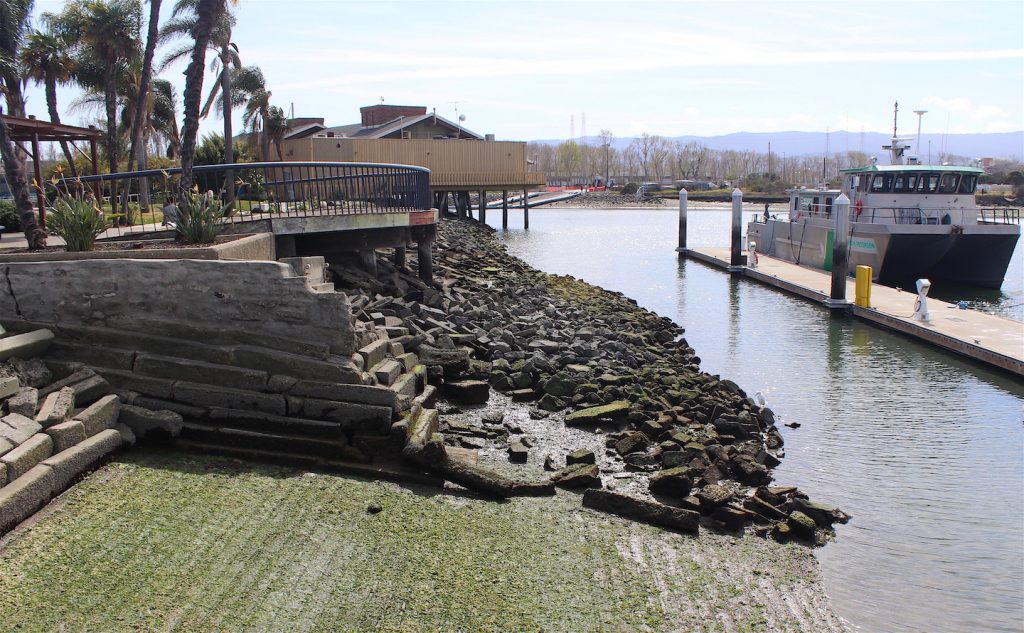
Most anglers fish straight out from the pier although both sides of the pier present narrow channels of water that can be fished (although the water is very shallow). To the left of the pier sits a dock mainly used by commercial boats, i.e., the patrol boat of the Department of Fish and Wildlife. The right side is close to a small marina that has boat slips for about 30 boats.
The fish that you will most likely encounter, especially if you’re fishing on the bottom during the summer and fall months are bullheads (staghorn sculpin), shiners (shinerperch), and small brown smoothhound sharks. Occasionally schools of topsmelt and jacksmelt may swing by the pier and if you’re fishing near the surface you may be able to fill a bucket with the good little fighters. During the summer and fall months, generally in the evening, a few striped bass may also show up and they can reach pretty impressive size. Although additional species of perch may show up in the winter and spring, it depends to a degree on the amount of rainfall. During heavy-rainfall years the water in the port can be pretty much like a freshwater lake and marine species will move further out into the bay. If it is a low-rainfall year, species like pileperch and blackperch may visit the area, and flatfish like starry flounder and sanddabs may make an appearance. Sturgeon are in these waters every year and some should swim into the port area but very few anglers will be trying for them at the pier. Stripers also will be present every year and more fishermen should try fishing for them here.
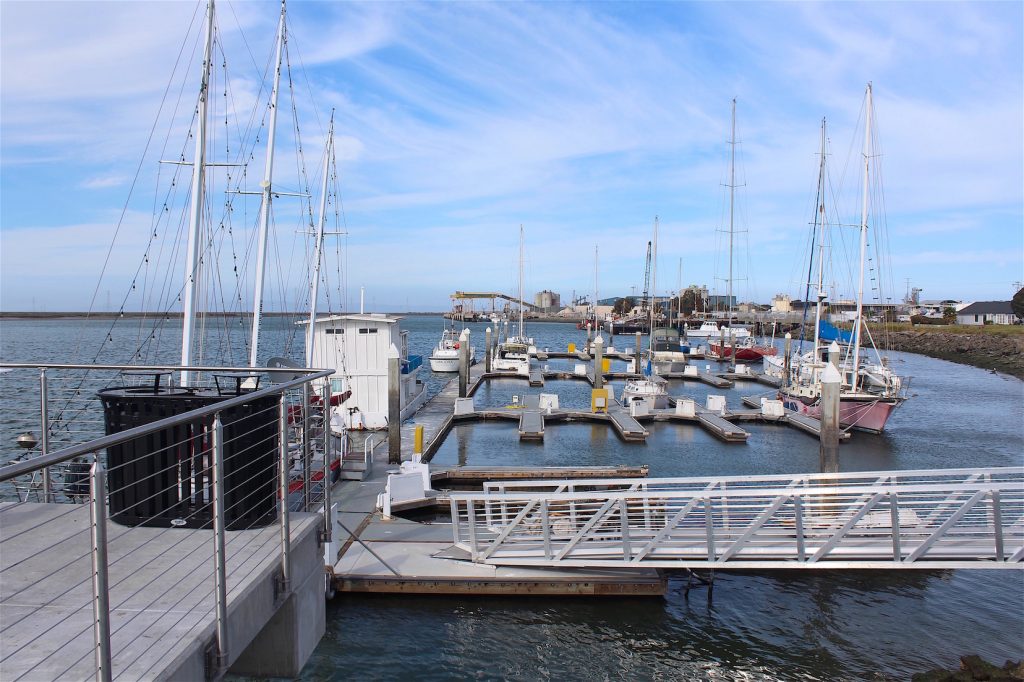
Fishing Tips. As mentioned, it’s good to have a little luck on your side but that’s true in most cases of fishing. The key is to be prepared for what’s available. During most of the year pile worms would be a bait of choice here. In the winter and spring try them on the bottom for flatfish and perch; for almost any time of the year try them just under the surface of the water for jacksmelt. Even if you are primarily fishing on the bottom, devote at least a little time on the top for the scrappy jacksmelt.
During the late spring to fall months, use cut squid, or a smelly fish like mackerel, to entice brown smoothhound sharks, a few leopard sharks, and bat rays to your hook. Don’t forget that the bat rays can often exceed 100 pounds in size so be prepared with a plan as to how you will land them (do I hear net).
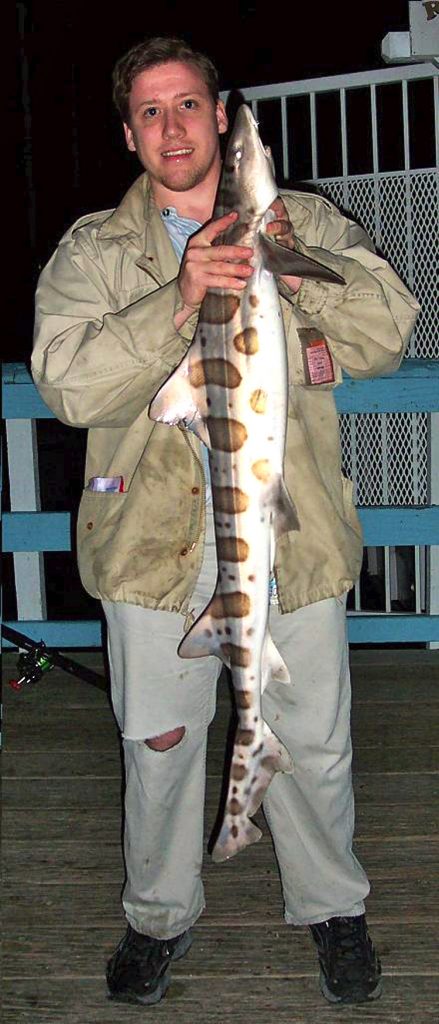
If you want to try for sturgeon, and, as they say, hope springs eternal, bring along a sliding leader and some grass shrimp, ghost shrimp or blue mud shrimp during the winter and spring months. You never know when a diamondback might show up even though your chances are not very high.
The same might be said for striped bass although they offer a more realistic hope. Stripers should be in these waters from about May until September or October but peak months will be July and August. Most of the stripers will hit baits on the bottom—pile worms, anchovies, sardines, live bullheads, and live mudsuckers. Since this pier is close to the water anglers should also try lures for the stripers—spoons like Kastmasters and Krocodiles, Hair Raisers, and a variety of plugs.
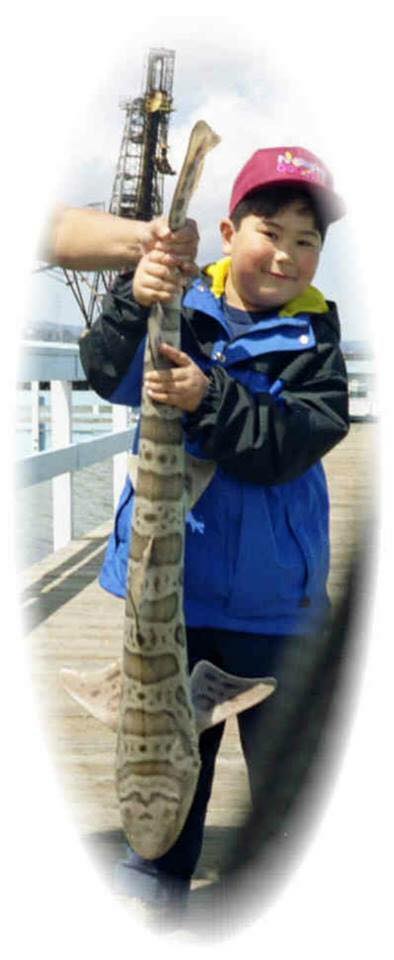
For the youngest anglers, ones content to catch a small shinerperch or bullhead, simply put a few (no more than three) small size 8 hooks on your line and bait each hook with a small piece of pile worm. Fish down toward the bottom or mid-depth for the shiners, cast out and fish on the bottom for the bullheads. Adults seeking the same species for bait can, of course, try the same thing.
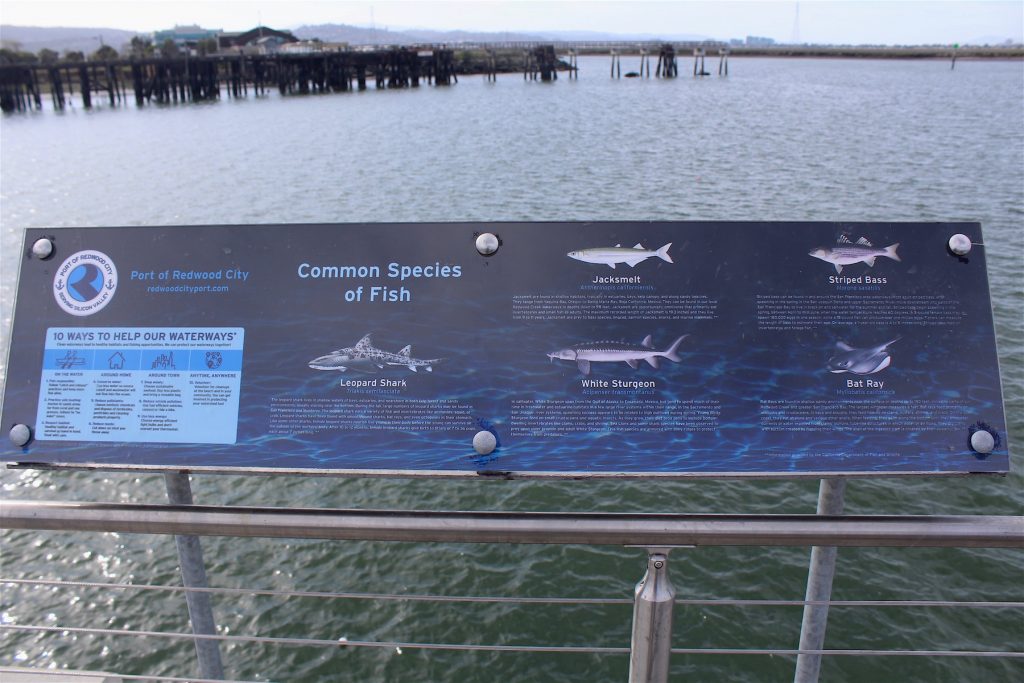
Potpourri
<*}}}}}}}}}>< — Fish surveys conducted by the California Department of Fish and Game between 2004 to 2009 showed a limited number of species of fish at the pier. Listed numerically they would be jacksmelt (by far), shinerperch, staghorn sculpin, leopard shark and topsmelt.
<*}}}}}}}}}>< — Interesting report — Date: February 28, 2002, To: Ken Jones; From: Jun Dimagmaliw; Subject: Redwood City Report
I’m one of your avid fan and faithful member of your board. I’ve been fishing this spot for 2 years now and love the peace and serenity this place offers. Fishing has started to pick up the last couple of weeks. It has been consistent leopard shark (between 18 in to 40+ in), smoothound and bat ray (biggest so far was a 32 in wingspan) with whole frozen bullhead and strips of squid on sliding rig as the main offerings.
<*}}}}}}}}}>< — I’m always interesting in the areas around the piers and this area is no exception. If you look straight ahead and off to the left from the pier you’ll see some large mechanical loaders on the other side of Redwood Creek; these are used to load salt for Cargill Salt (formerly Leslie Salt), and sometimes there are pretty impressive mounds (or mountains) of the bitter stuff. Opposite the pier, and slightly to the right, sits Bair Island (and the outer island is shared with the San Francisco Bay National Wildlife Refuge). To the right of the pier, down the shoreline, are a series of wharves and sometimes large ships loading and unloading everything from scrap metal to concrete.
<*}}}}}}}}}>< — A nearby site that should be visited and supported by anglers is the Marine Science Institute. The institute, founded in 1970, offers hands-on learning for students of all ages. For schools, the institute offers tours on the bay in the institute’s 90-foot-long research vessel—the Robert G. Brownlee. Once aboard, students use research equipment to collect plankton, water samples, and conduct hydrology tests. Students also net several species of fish. Shoreside, a number of different activities are also offered including ocean labs and activities geared to the age level of the students. Although primarily a working institute, and especially busy during the summer when kids are present nearly every day, the good folks at the institute seem willing to let visitors take a look at the tanks of fish and various other organisms. Most interesting to me was the tank holding the dozen or so small leopard sharks and one cute and friendly little 7-gill shark. To reach the facility, turn north from Seaport Blvd. onto Chesapeake Drive and follow the signs to the institute.

Marine Science Institute — 500 Discovery Parkway — Redwood City, CA 94063 — info@sfbaymsi.org — Tel: 650-364-2760
<*}}}}}}}}}>< — Special Bay Area Regulations:
- A perch closure exits in San Francisco and San Pablo Bay from April 1 to July 31. No perch may be kept other than shinerperch (20).
- In San Francisco and San Pablo Bay a fishing line may not contain more than three hooks.
Sturgeon Regulations:
- A sturgeon report card and tags are required for anyone fishing for or taking sturgeon. (a) The card must be in the angler’s possession; (b) a tag must be used for any sturgeon retained by the angler; (c) the angler must record information on the Sturgeon Report Card immediately after catching and keeping or releasing the sturgeon.
- White sturgeon can only be kept from 40-60 inches; larger and smaller sturgeon must be released.
- Green sturgeon may not be taken or possessed.
History Note. As one of only four deep-water ports on San Francisco Bay (in addition to San Francisco, Oakland and Richmond), and the only one in the South Bay, Redwood City has a long tradition of shipping and wharves. This area was part of the Rancho de las Pulgas (the fleas) grant given to Don José Darío Argüello in 1795. The grant stretched from San Mateo Creek on the north to San Francisquito Creek on the south. Redwood Creek ran through Rancho de las Pulgas into a slough of the bay and provided a natural point for shipping. In time, the point acquired the Spanish name Embarcadero de las Pulgas.
In 1850, after the coming of the Americans, the Embarcadero became an important lumber port. Mills in Woodside and Searsville sent a steady supply of redwood lumber from the groves of the nearby mountains, and the port’s wharves were stacked with wood destined for San Francisco, Oakland and Sacramento. By the 1860s several businesses had been started near the port, most associated with shipping or the transportation needed to bring goods to and from the port. Most famous was probably the McLeod Co. that built oceangoing schooners averaging over a 100 feet in length. Others included such occupations as wagonmaking and blacksmithing. Around this early economic activity would develop the town of Redwood City. An interesting picture from 1878 shows the now Americanized “Redwood Embarcadero” and its waterway full of ships, sailboats and rowboats.
By the mid-1950s the port’s main products had changed from lumber to cement (Henry Kaiser’s Permanente Cement) and salt (Leslie Salt), and the nearby redwood groves had largely either been cut down or turned into state parks. The creek itself, onetime center of the town, now rests underground for much of its length.
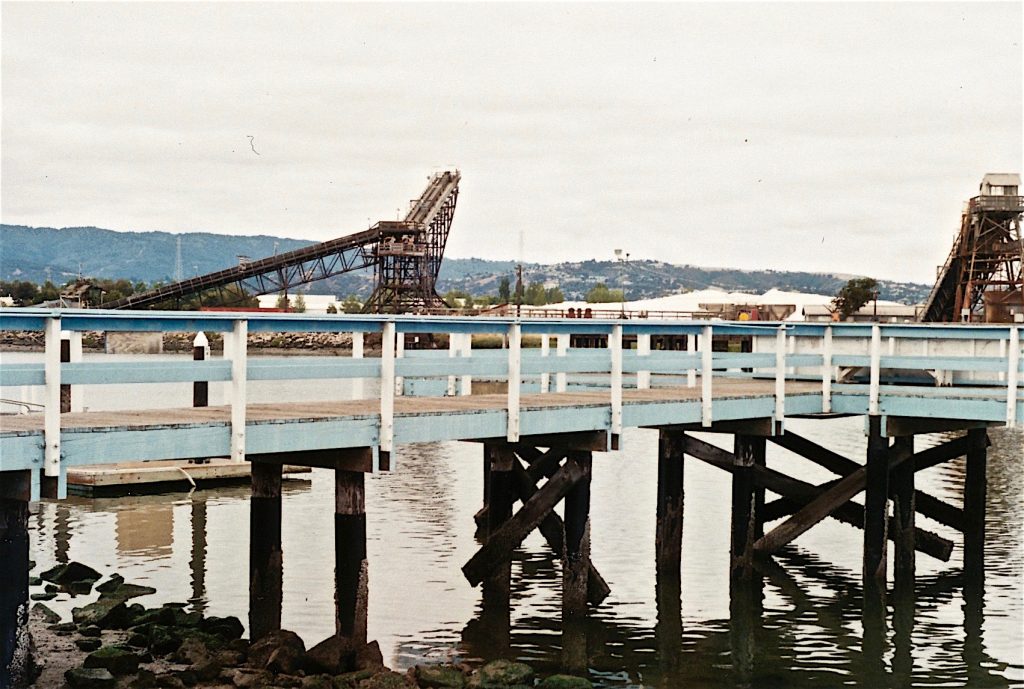
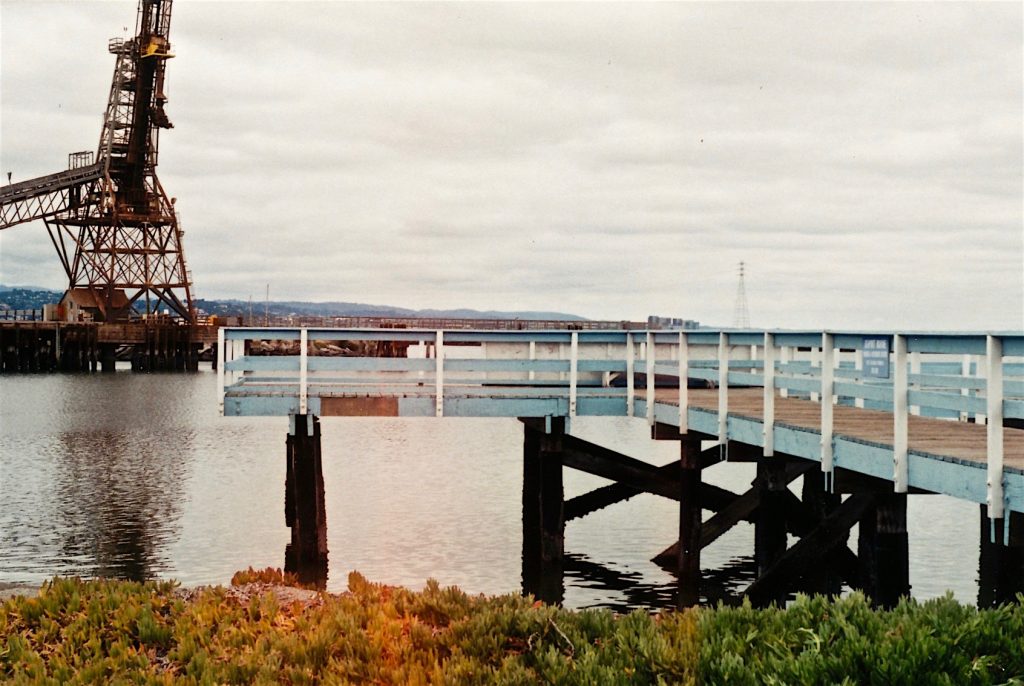
Redwood City Marina Pier Facts
Hours: Open 24 hours but there is no light on the pier.
Facilities: The pier itself is pretty much barren of facilities although there is one light. Restrooms are found across the large parking lot near the Spinnaker Sailing office. About a dozen free parking spaces are found adjacent to the pier while additional spaces are found in the large parking lot. A seafood food tuck with good seafood is found most days close to the pier.
Handicapped Facilities: None really. The surface is concrete and the railing is approximately 42 inches high.
How To Get There: Leave US 101 (Bayshore Freeway) at the Seaport Blvd. exit (also marked Port of Redwood City and Redwood City Marina) and drive east until you see Seaport Court. Turn left and go to the back of the parking lot behind the buildings.
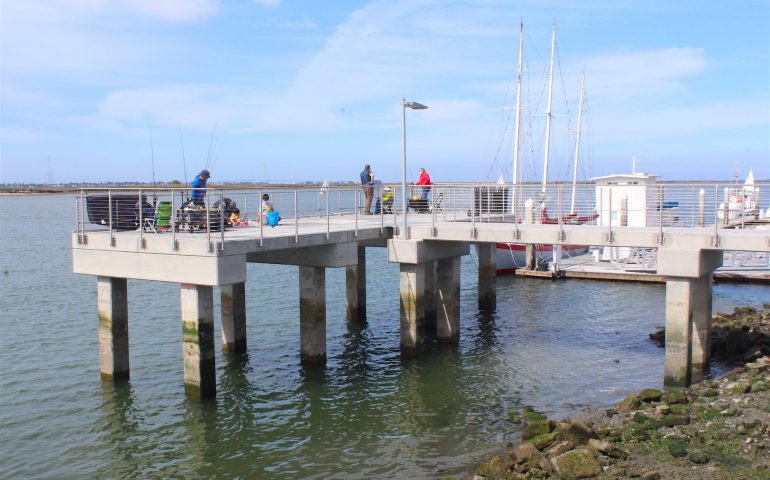
This pier is closed, I don’t know why
Apparently damaged by visitors.
I called the Port of Redwood City and they told me that the safety railing was damaged by some people standing on it. A builder was contracted to fix it, but there isn’t an estimate on when it will reopen yet.
Thanks for the report! Unfortunately the glacial response of government to items like this is a little frustrating.
Has the Pier reopened – Saw the recent news article but it is unclear if still fully closed?
Still have gotten any word if the new pier has reopened? Anyone fish it in 2024? I know you can probably cast at Open Wave in the back if they haven’t restricted this entire area to fishing now.
That’s huge! The same might be said for striped bass although they offer a more realistic hope
Has the pier already reopened?
Redwood City Marina Pier’s revamp offers a refreshed angling experience with diverse catches amidst a historic and industrial backdrop.
The newly rebuilt pier promises a blend of tradition and modernity for avid anglers seeking a variety of fish in a unique setting.
Two years later and the pier is still closed because of failed safety railings. Why would the city engineers provide a permit for such a flimsy railing knowing that normal public use would be more severe than the residential grade cable railing could handle? Get it fixed with a suitable product and let the public get back to using the pier.
Thanks your post is very helpful.
Dino Game is engineered to provide an engaging and sophisticated gaming experience that transcends conventional boundaries
At its core, Slice Master is a puzzle game that requires players to slice through various objects in creative ways to achieve specific goals.
Welcome to Funny Moments! We bring you funny fails, epic bloopers, viral memes, and hilarious moments that will keep you entertained! If you love comedy videos
In the vast world of online games, Tiny Fishing has become a beloved option for players seeking a simple yet captivating game to unwind and enjoy
Love visiting this pier!!
Birla Punya estate infrastructure development and proximity to premium apartments like, Birla Punya park make it a prime location for real estate investment. The reputation of Birla Punya to the project, assuring homebuyers of quality construction and timely delivery. As continues to develop, the demand
Welcome to Planet Clicker, the ultimate destination for fans of space exploration and idle gaming!